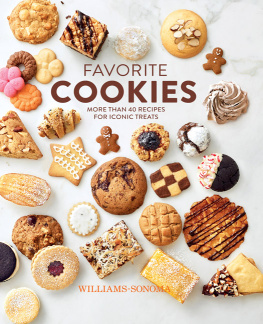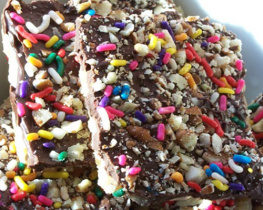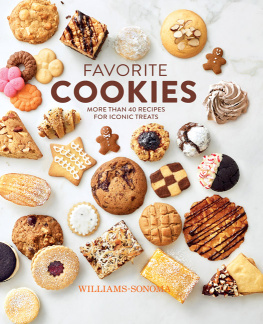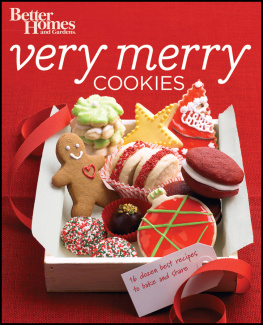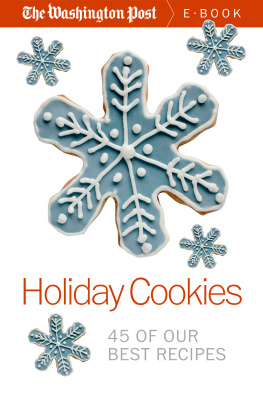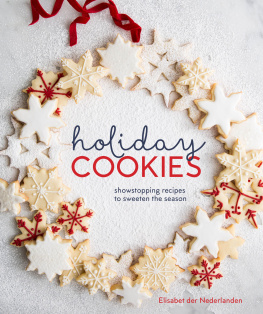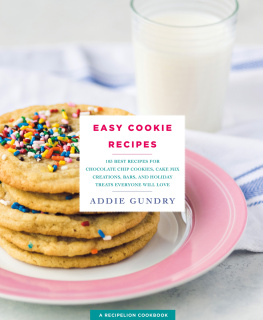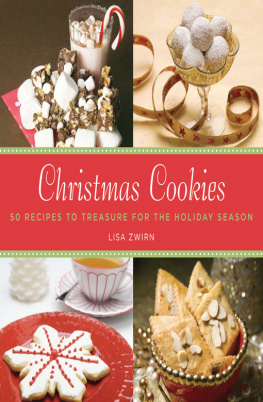FAVORITE
COOKIES

Photographs Annabelle Breakey



COOKIE BASICS
What could be better than the aroma of freshly baked cookies coming from the oven? Perhaps only the first sublime bite of a warm chocolate chip cookie with its melted chocolate bitsa moment of pure delight. Cookies evoke so many wonderful emotions; they fill your kitchen with the aromas of childhood and the memories of holiday time. Nothing is more satisfying than dipping a hand into the cookie jar to instantly indulge your sweet tooth.
The recipes in this book begin with our favorite selection of classic and versatile drop cookies, perfect for any day of the year. Serving these fresh from the oven, like for kids (or kids at heart). And finally, 17 festive holiday cookies bring to life dreams of peppermint, gingerbread, rugelach, and a winter wonderland of flavors.
The secret to successful cookie baking starts with the dough, so in the next few pages we cover everything from equipment essentials to rolling, cutting, and shaping dough. Cookie decorating is easily doable with a few basic tools and our handy how-tos. Many of these recipes are simple enough to make that you can enlist little hands to help. And dont miss our tips for proper storing and beautiful gift giving.
We celebrate the cookie and all of its different texturescrispy, chewy, or downright gooeyand encourage you to experiment with your favorite flavors and ideas for mix-ins. Youll find exciting flavor variations throughout, from . Perhaps youll find a new favorite or develop a new holiday tradition. Get creative with whatever shapes, colors, and designs you like. Just dont forget a big glass of cold milk.

COOKIE BASICS
There are several types of cookiesdropped, rolled and cut, pressed, and sandwichand we love them all. While many do not require any special tools, some might need a specific pan or piece of equipment.
Tool Kit
In addition to the standard suite of baking tools (mixing bowls, measuring cups, and baking sheets), its good to have a few other items on hand before you get started.
An electric stand mixer is handy for mixing dough, and wire cooling racks are essential for allowing air circulation so that cookies cool quickly and evenly.
Use parchment paper or silicone baking mats to line baking sheets to prevent dough from sticking. And, of course, a rolling pin and a selection of cookie cutters are a must for making Christmas cookies!
For decorating, be sure to have an offset spatula (also called a palette knife) on hand, as well as a piping bag and an array of tips (). Gather several small bowls (dishwasher-safe materials make cleanup a breeze) for mixing icing. Small paintbrushes to spread icing, paint designs, and brush on luster dust are also useful.
Youll need a cookie press for our .
Ingredients
Most cookie recipes use the same stockpile of ingredients: butter, flour, sugar, eggs, and vanilla or other flavorings. Using the highest quality of each yields the best results. Start out with all your ingredients at room temperature, unless the recipe instructs otherwise. The temperature of the butter is important: if the butter is too cold, it will not fluff up or cream properly, and if it is too warm or nearly melted, it will be too thin to fluff up at all.
Measuring
Professional bakers use a kitchen scale to measure dry ingredients, but most home cooks use cups and spoons. Whichever method you use, be sure to measure precisely and use the same method for the entire recipe.
Serving
From a cookie jar brimming with chocolate chip cookies to a vintage tray stacked with brownies, presentation ideas are endless. Keep in mind that some recipes have specific serving instructions; for example, madeleines are best served warm from the oven, dusted with confectioners sugar.

COOKIE CARE 101
Cookie dough and finished cookies are delicate. It is important to handle cookies with care at every stage of the processfrom prepping, rolling, and cutting to cooling, decorating, and storing.
Shaping & Freezing
Making great cookies starts with the dough. Temperature is key! For best results, follow the instructions in each recipe regarding chilling and wrapping cookie dough; many require refrigerating the dough for at least 1 hour or up to overnight. Rolled cookie dough should never get too warm or it will spread while baking. When making . If working with frozen dough, let it stand at room temperature for a few minutes before shaping or slicing.
Baking & Cooling
Oven temperatures vary, and since cookies have short baking times, it is important to watch them closely so they dont burn. Check for doneness a couple of minutes before the recipe indicates. To ensure even cooking, rotate the baking sheets halfway through the baking time. Use wire racks for cooling; they allow air to circulate beneath the cookies, which helps them cool quickly and evenly. When making bar cookies, use the size of dish called for in the recipeusing a different size will change the baking time and may affect the texture.
Storing & Packaging
Most cookies will keep well in an airtight container, layered between sheets of parchment paper, at room temperature for a few days. To pack bar treats for picnics and parties, wrap them individually in aluminum foil or waxed paper. A dozen beautifully baked cookies can easily become the perfect hostess or holiday gift. Wrap cookies in waxed paper and place on colorful tissue paper in a sturdy decorative box or metal tin, then tie with festive ribbon.
Troubleshooting
The cookies spread too much during baking. The butter was too soft when added, or the dough was placed on a hot baking sheet.
The cookies are burned on the bottom. The cookies were too thin, the oven was too hot, the baking sheet was too thin or placed too low in the oven, or the baking sheets were not rotated during baking.
The cookies did not bake evenly. The baking sheets were not rotated during baking.
The cookies fell apart when removed from the baking sheet. The cookies were removed from the baking sheet too soon.
The cookies stuck to the baking sheet. The cookies were not baked long enough or were left too long on the baking sheet.
DECORATING PRIMER
While making cookie dough is a science, decorating cookies is definitely an art! So let your creative side shine through (perhaps with a little luster dust), and use our guide to help inspire your masterful creations.
Royal Icing
It all begins with royal icing. This stiff white icing, made from confectioners sugar and egg whites or meringue powder, got its name after it was used to ice Queen Victorias white wedding cake celebrating her marriage to Prince Albert in 1840. (See recipe, facing page.)

